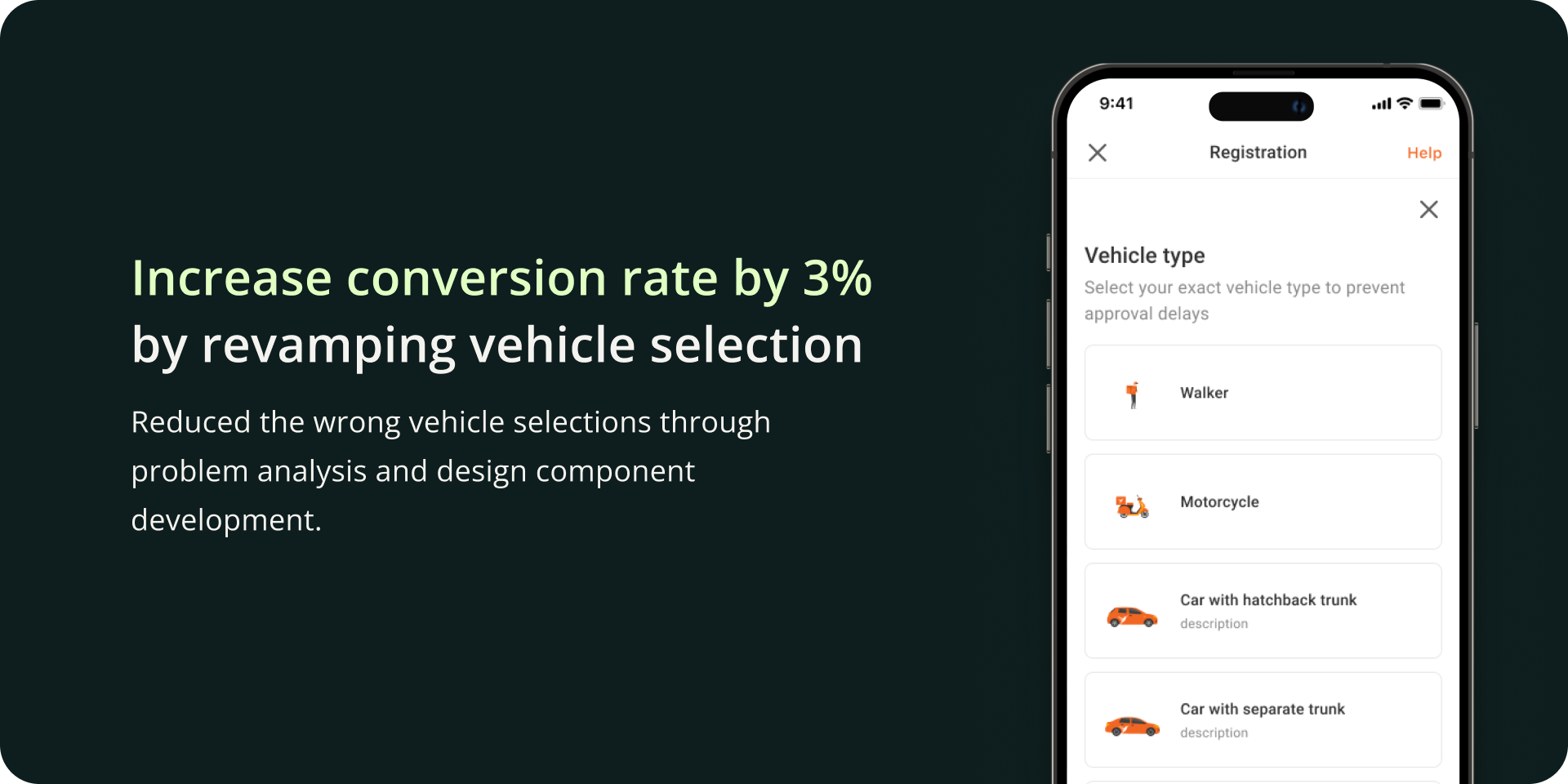Inform product decisions through fail delivery experience research
Found key insights on user behavior, which helped develop help center content, using surveys and in-depth interviews

Lalamove
Lalamove is an on-demand delivery platform that connects 13 million users with 1.2 million driver partners in 11 markets across the world. Lalamove driver-partner app is a tool for drivers to receive and manage delivery requests from customers.
ROLE
As a lead researcher for 6 weeks, I was responsible for:
• Initiating and leading the research effort
• Defining the objectives and methodologies to get buy-in from the design, product, research, and local operation teams
• Recruiting the participants in collaboration with the local operation teams
• Interviewing 10 participants with designers, researchers, and local operation teams in local languages
• Synthesizing and presenting findings to the product team and local operation team
Research gave insights for the product
Helped shape the new help center content
Provided insight into driver behavior that would be useful moving forward
CHALLENGE
Failed deliveries cause frustration for customers who are waiting for their packages and drivers who feel they have wasted their time.
In many cases, drivers have no clear instructions on what to do when they cannot deliver packages, leading to additional CX contacts and eventual offline deals.
Though failed delivery is a crucial aspect of our service, it's an area we hadn't researched before. When the operation team requested a feature for drivers to return goods to the pick-up point in case of delivery failure, it piqued my curiosity, leading me to initiate research to better understand what drivers do when they can't complete a delivery.
Objectives:
• Understand the current process when a driver cannot deliver
• Understand the payment/charging agreements between users and drivers
• Understand in which context drivers will reach out to CX instead of settling with the customer
• Understand the user experience with failed deliveries
• Identify opportunities to improve the failed delivery experience
METHODOLOGIES
Combining a survey and interviews to understand driver and customer experience
I dedicated more time to interviewing drivers to understand driver experience in research, as the main actor in fail delivery is a driver with a package. While acknowledging the customer experience's importance, my research approach for customer experience was more quantitative and less detailed via a survey.
Focused on 3 markets with many corporate clients
Corporate clients tend to order a high volume of orders, and they are more willing to give feedback to us. Moreover, the product team envisioned any enhancement to failed deliveries would be available for paid clients.
Survey 16 corporate customers via Google Forms to understand the overall theme of customer pain points
I managed to get feedback from 16 corporate customers whom we are in contact with through our account managers in the 3 markets.
Key questions:
• What do customers expect to happen after drivers are not able to deliver?
• When do customers know about the failed delivery?
• From past experience, do customers usually pay for the return/rescheduled deliveries?
• Do customers have pre-arrangement/SOP with drivers in case recipients are unavailable?

Interview 10 drivers via a video call to understand the driver's failed delivery process and pain points in depth
We managed to interview 10 drivers who have contacted CX in the past about failed deliveries or have marked orders as failed deliveries in the app.
Key questions:
• What would drivers do when they cannot meet recipients?
• What are their preferences and past experiences on what to do?
• How long are drivers willing to wait?
• How much do drivers expect to be paid?
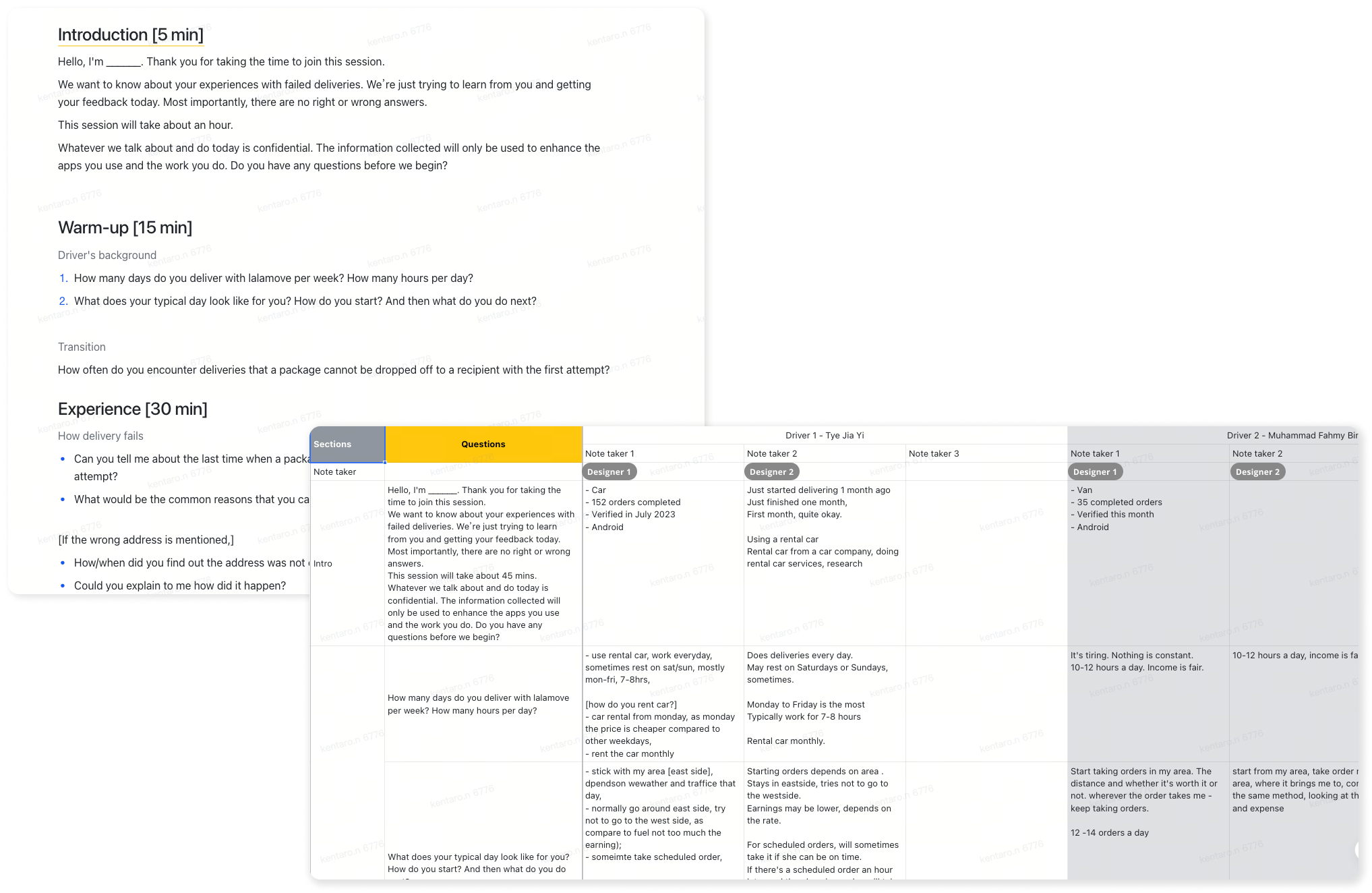
Report
Before we start
Understanding the context behind failed deliveries
I consulted with the local operation and CX teams in the 3 markets to understand more about failed deliveries before I began to talk to customers and drivers.
Failed delivery cases are typically resolved, but the local CX team invests time in communicating with drivers.

The current SOP is similar across the market, but certain steps vary based on the market condition.

All the markets compensate drivers based on distance by adding stops or creating new orders, and customers need to pay for any compensation via in-app wallet or cash.

Stakeholder communication is a major challenge for the CX team, and minimizing contact should be considered in the solutions.
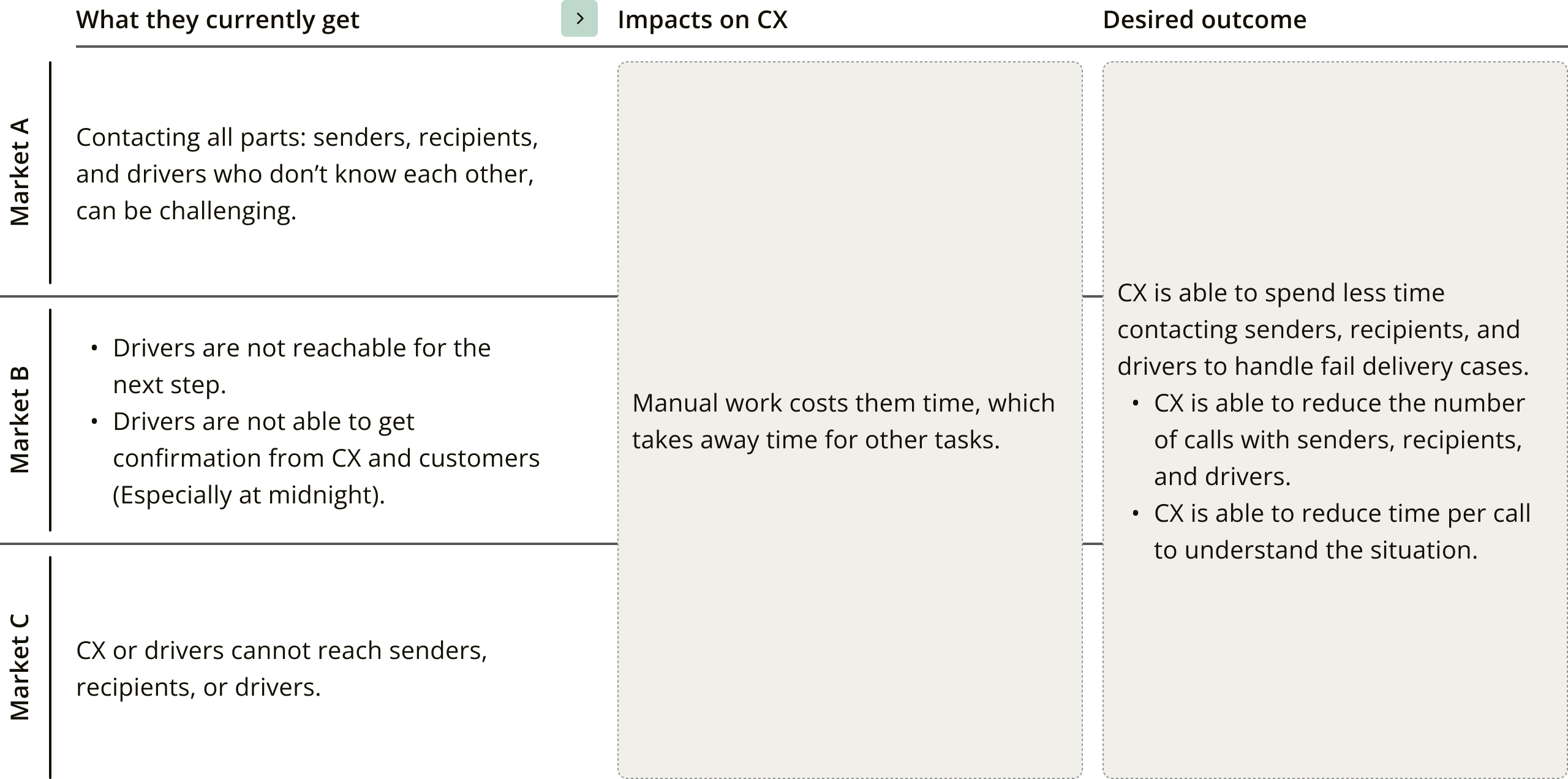
Customer voice
Customer don’t want to spend money
Customers face challenges at every stage of failed delivery.
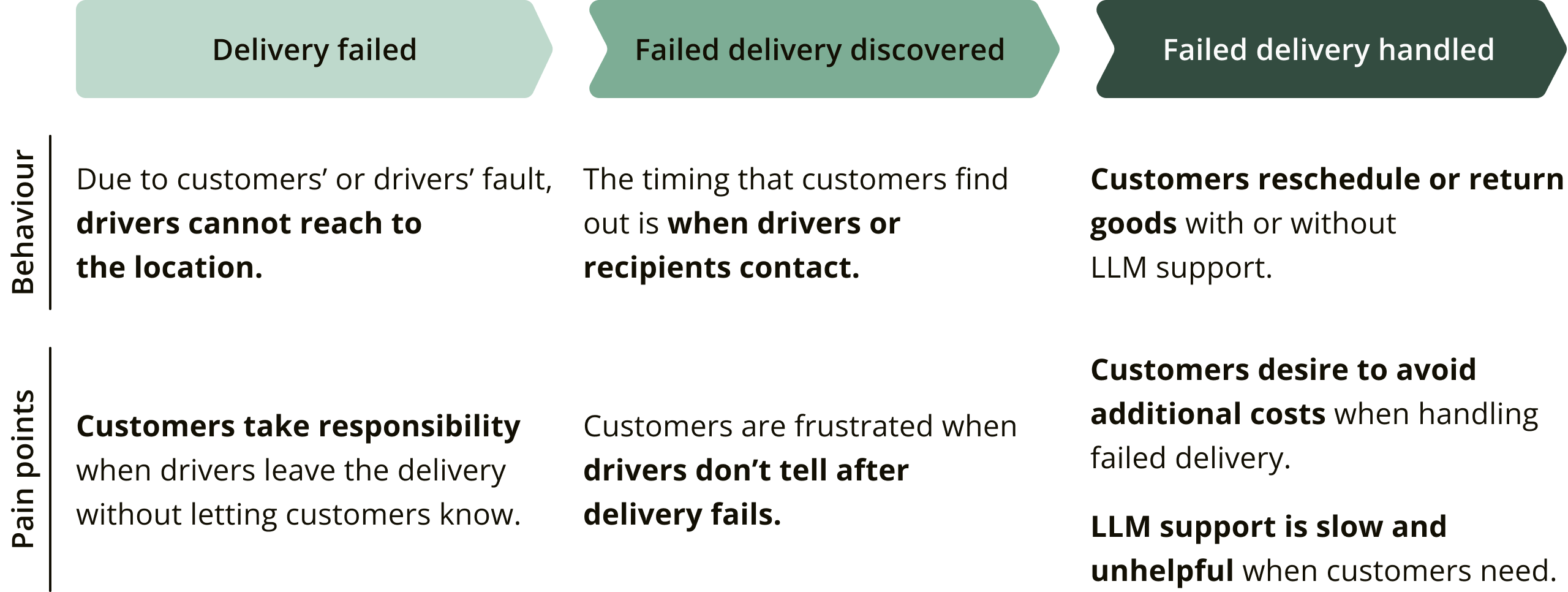
Address issue is the most common reason that delivery fails across the markets.
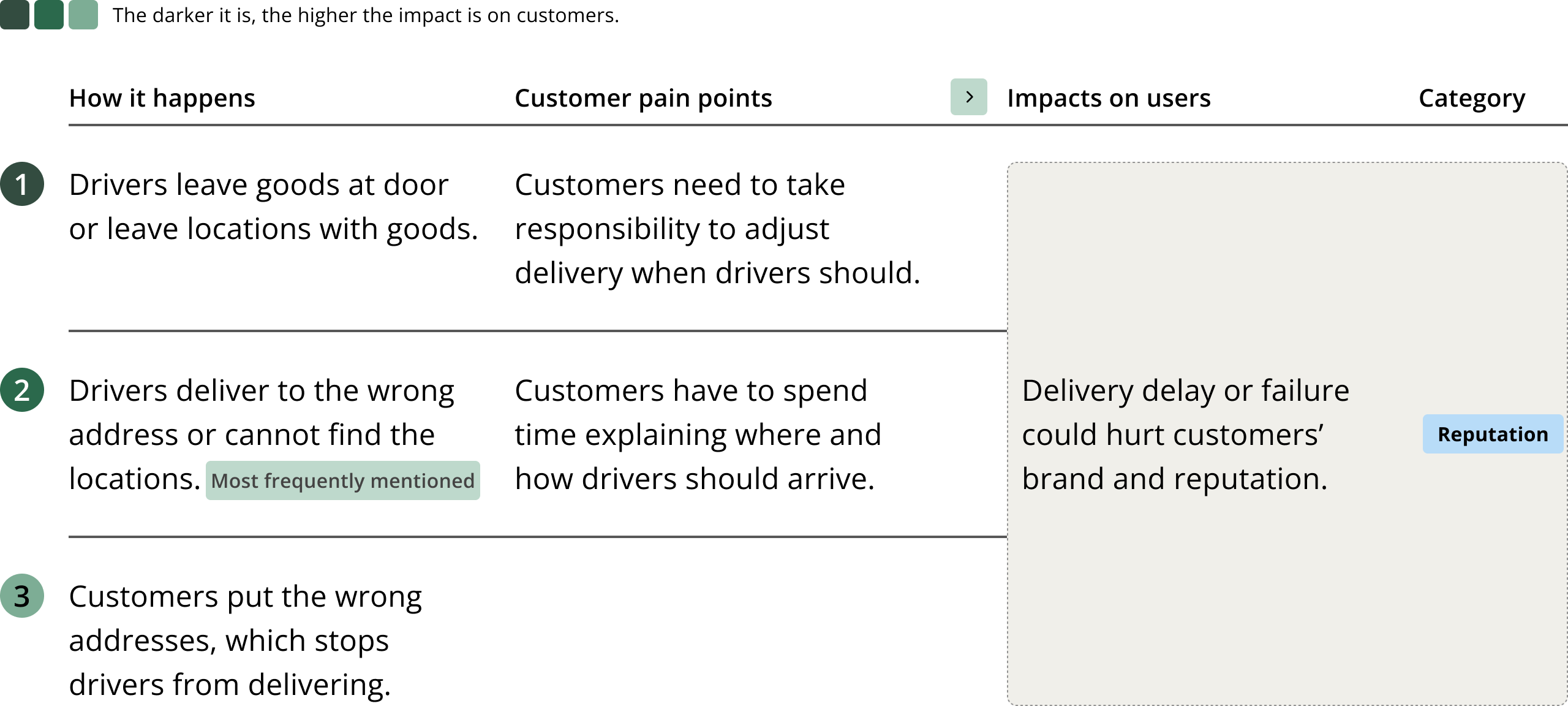
Customers are most likely to find out deliveries being failed when recipients contact them about delivery.
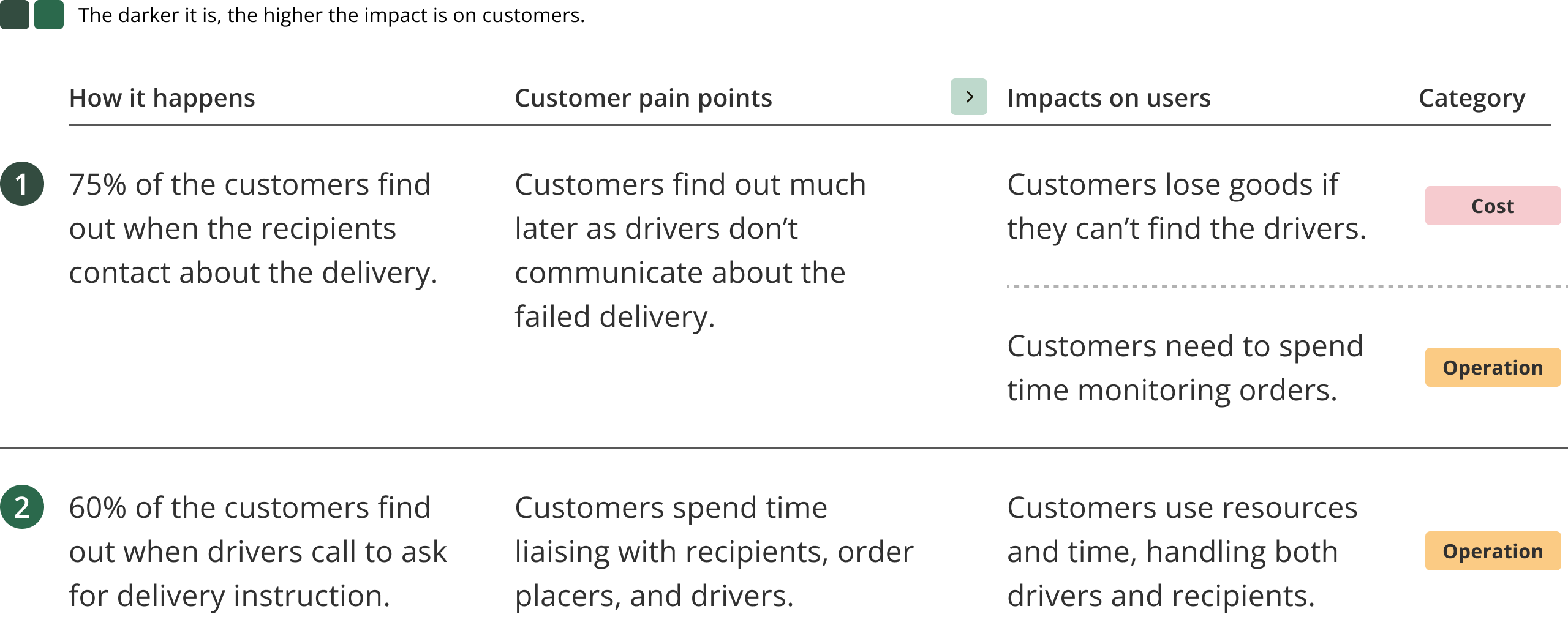
Customers want to minimize costs, communication with drivers, and failed deliveries.

Customers want to adjust delivery by returning or rescheduling delivery without additional costs.

Driver voice
Drivers prioritize efficiency over compensation
The flow aligns with local team SOPs, but contacting CX is a process bottleneck according to the drivers.
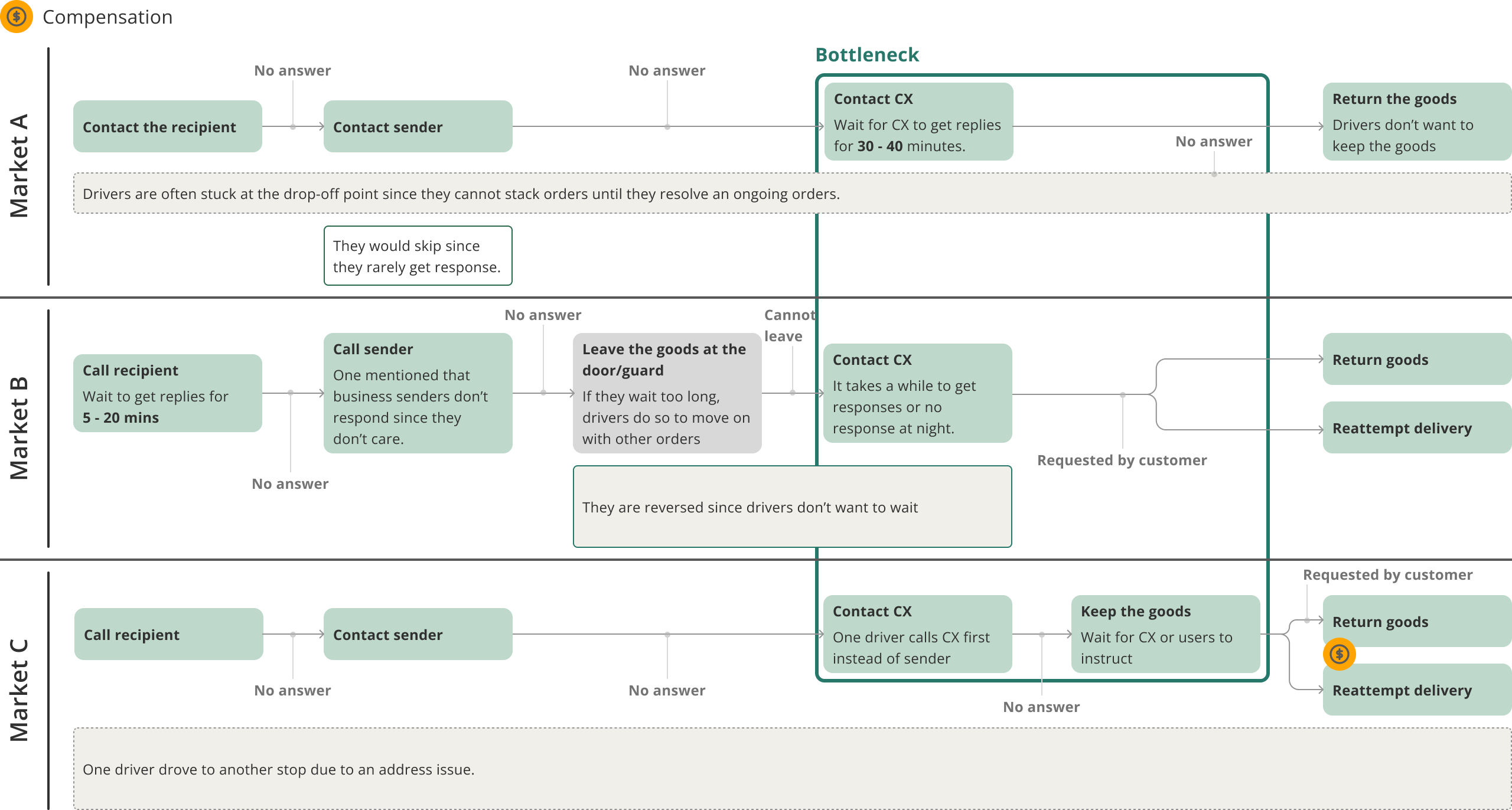
Rather than getting compensated, drivers want to resolve failed deliveries quickly.
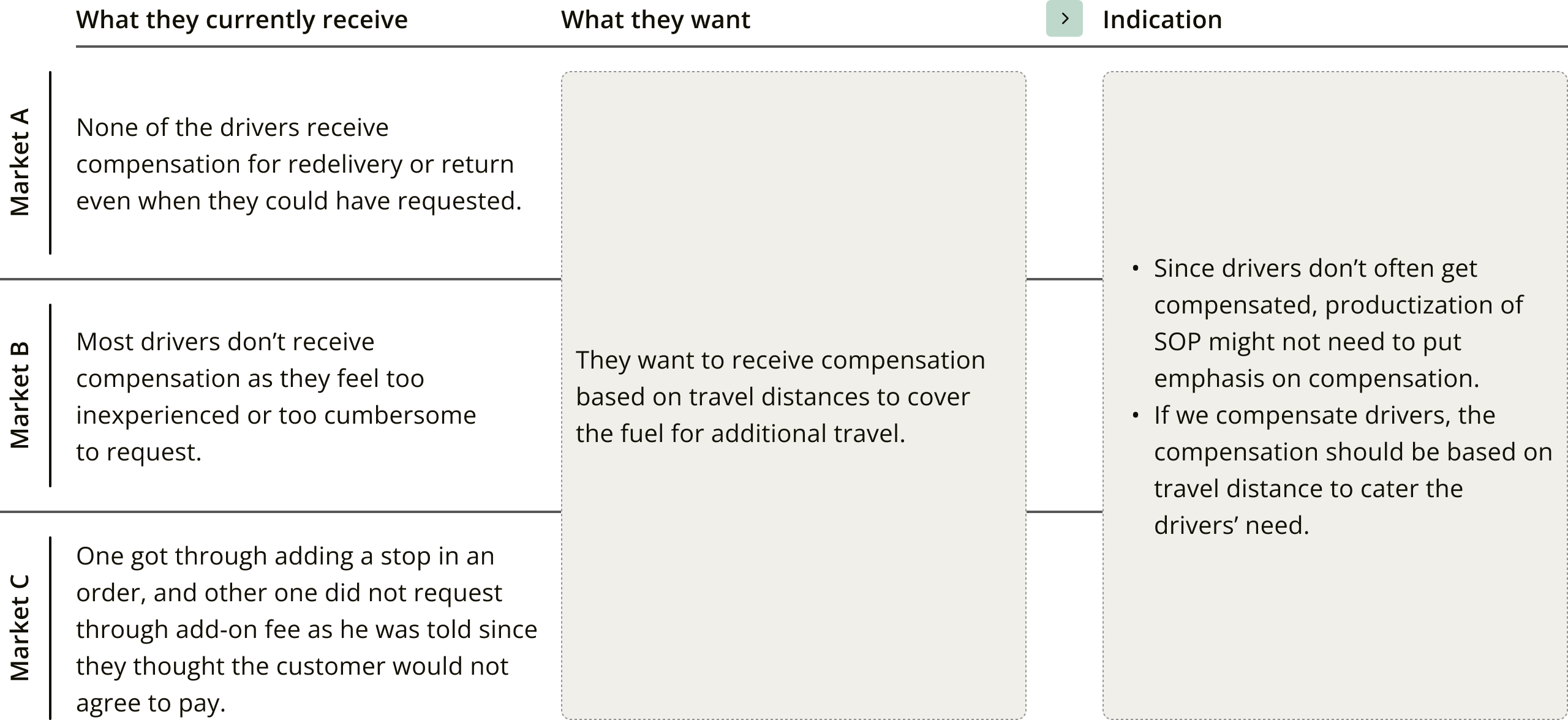
Drivers won’t remember or pay attention to the taught SOP but instead navigate situations through experiences.
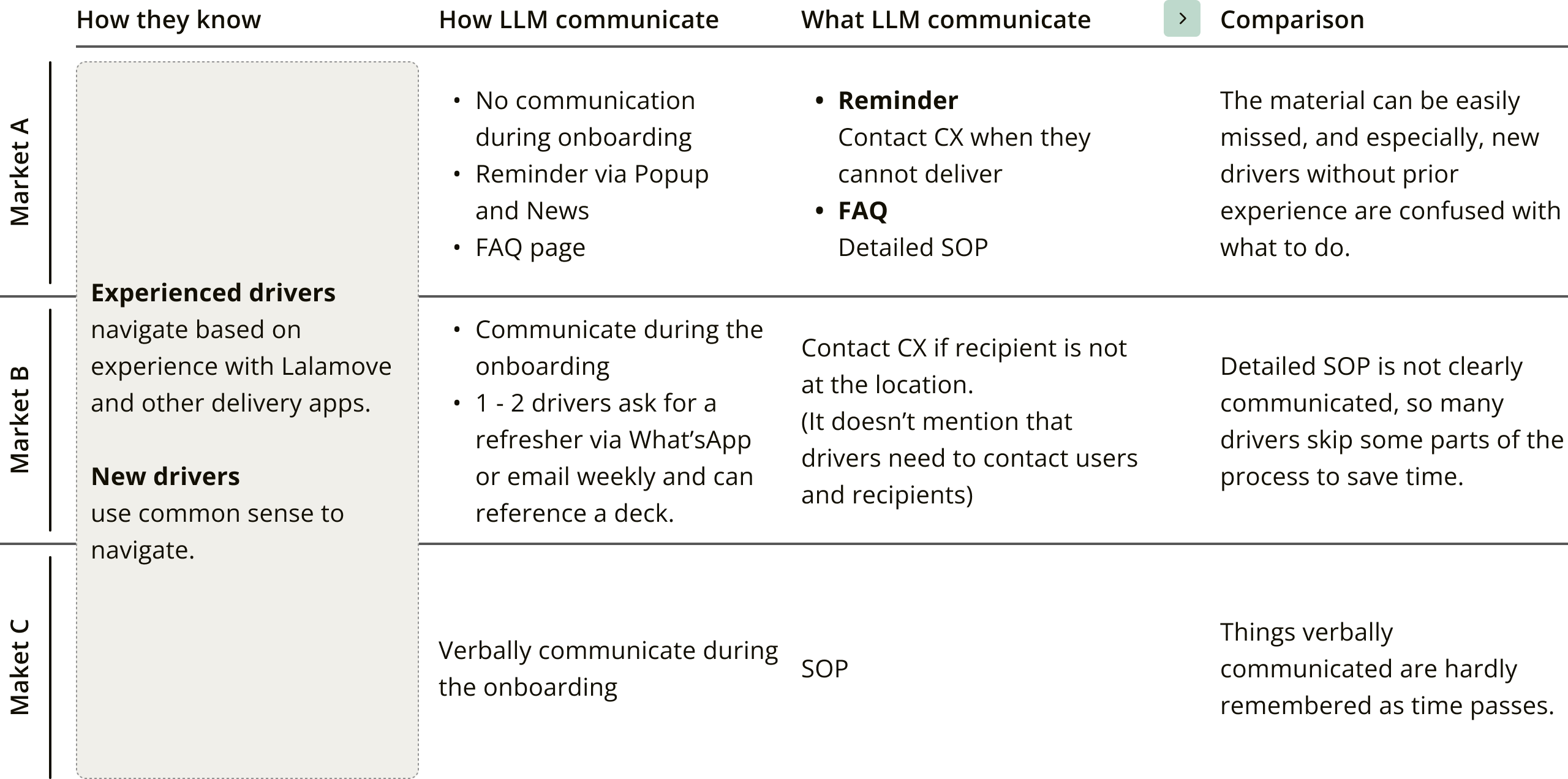
Drivers want to reduce the time to handle delivery by reducing contacts with CX and judging what to do faster.

Opportunities & Suggestions
Reduce the frequency and length of the contact
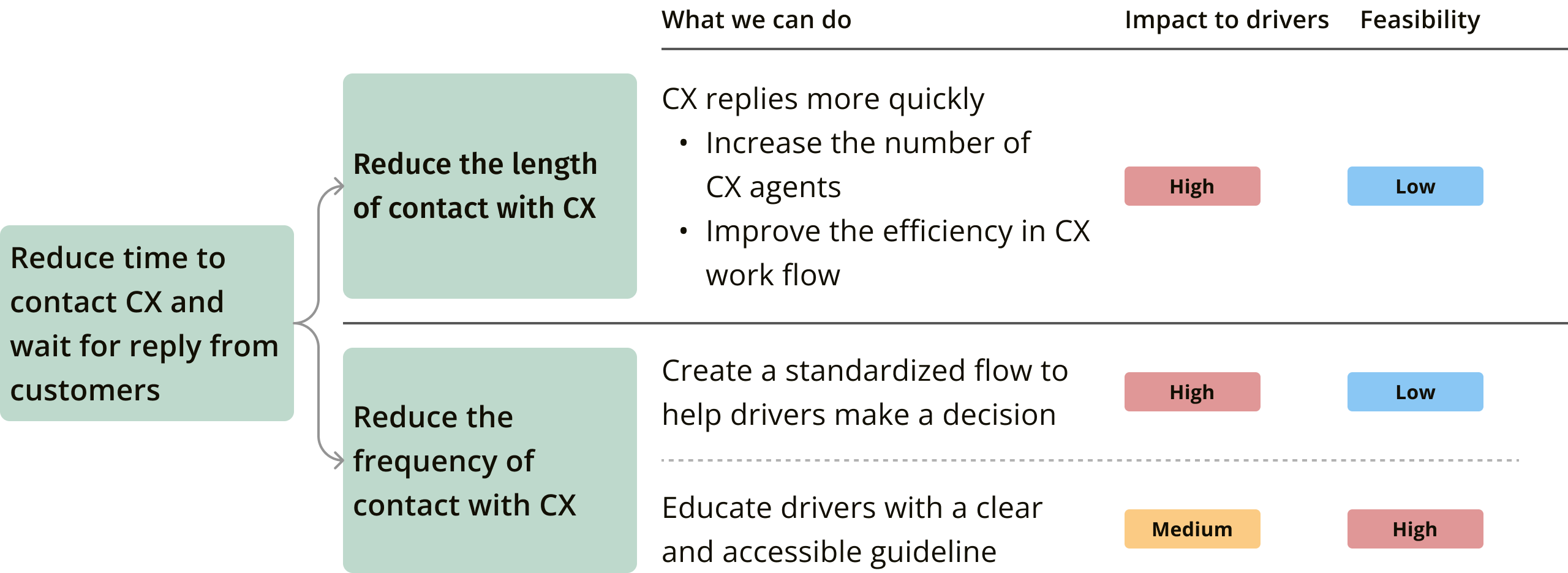
Suggestion 1:
Improve local CX team's operation
To reduce call length, the local CX team should focus on improving call efficiency. We need to gain a better understanding of the current operations of the CX team.
Why it matters
• Waiting for CX to reply takes the longest time during the failed delivery handling.
• All the drivers complained about how slow CX replies to them in the chat. Slow CX response has been mentioned frequently in the previous research.
Considerations
• Given the current business strategy of cutting costs, it’s impractical to increase manpower.
• We need to look at the CX workflows holistically to find out where they should spend the most time and where they can cut.
Suggestion 2:
Create a standardized flow to help drivers make a decision
Standardizing a failed delivery flow can aid drivers in decision-making without contacting the CX team, but the SOP in the product must remain flexible to accommodate market-specific needs.
Why it matters
• A standardized flow in the app could guide drivers without the frustration of slow CX response.
• In some markets, drivers are not allowed to have multiple orders simultaneously; Delayed delivery completion impacts driver earnings by wasting time.
Considerations
• It needs to be highly customizable, and it is hard to productize the SOP in the app due to the cultural factors.
• High risk of fraud can be foreseen.
• It needs multiple layers of validation by CX and customers.
Suggestion 3:
Educate drivers with clear and accessible guidelines
Drivers require clear and accessible guidelines to efficiently handle failed deliveries, enabling them to make quicker judgments without wasting time.
Why it matters
• New drivers complained about a lack of information and education on failed delivery handling and compensation.
• Some drivers are not following some required steps, which might lead to longer delivery time and goods loss.
Considerations
• Guideline content should be flexible to adapt to the market needs.
• It is relatively inexpensive to create a guideline in the app rather than creating a new flow in the app.
The research findings were instrumental in developing the content for our new driver help center.
We designed content to assist drivers when they encounter delivery failures. This FAQ aims to empower our drivers to resolve issues independently.
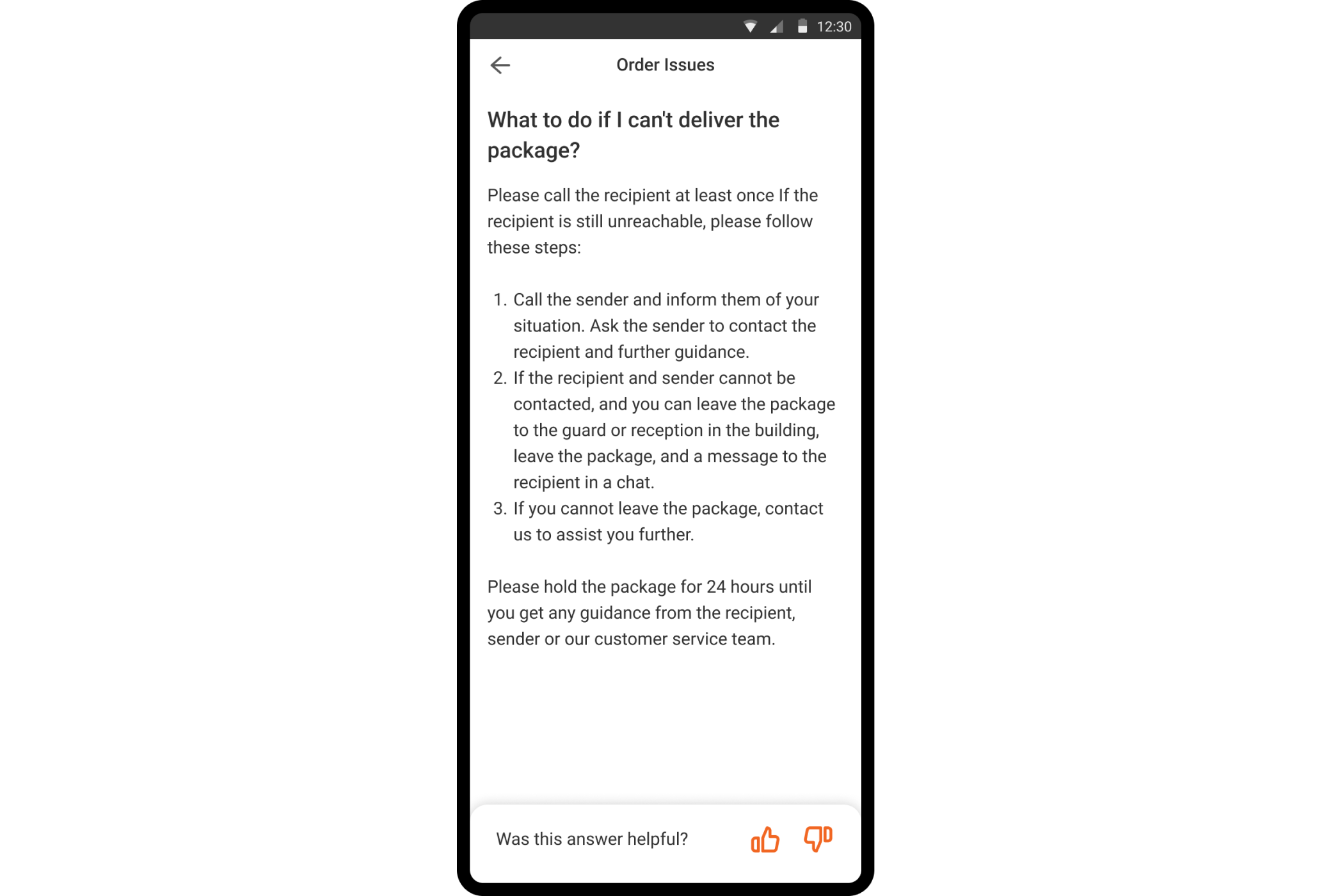
A key insight gained to leverage in our design
Drivers prioritize efficiency over compensation, a key insight to leverage in our design. This insight formed a core design principle for our platform. While financial gain is crucial for drivers, they care more about completing orders swiftly with minimum hassle, rather than battling for compensation.
Next steps
Based on the insights and recommendations, I will propose a new feature in the following year.
As we address business needs, I will advocate driver-centric features based on the driver feedback.
I continue advocating for research to understand our users.
Due to time limitations and team habits, we often bypass research. I'm working to help create a culture where research is more valued.
Learnings
Thorough briefings with the local team proved more crucial than anticipated.
During online interviews with their assistance, language, and cultural differences may have influenced phrasing. Next time, I will offer a more detailed guide to asking questions effectively and clarify research intentions.
Great learning experience communicating with diverse stakeholders to gain support and buy-in.
Engaging with diverse stakeholders, including product, research, and operation teams across three markets, was rewarding. It enhanced my communication skills by effectively explaining reasons, objectives, timing, and methods to gain support for the research.
